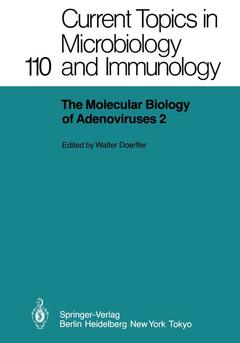Description
The Molecular Biology of Adenoviruses 2, Softcover reprint of the original 1st ed. 1984
30 Years of Adenovirus Research 1953-1983
Current Topics in Microbiology and Immunology Series, Vol. 110
Coordinator: Doerfler W.
Language: English
Subjects for The Molecular Biology of Adenoviruses 2:
Keywords
biology; development; gene; genes; molecular biology; oncogene; oncogenesis; protein; virus
The Molecular Biology of Adenoviruses 2
Publication date: 05-1984
Publication date: 05-1984
The Molecular Biology of Adenoviruses 2
Publication date: 02-2012
268 p. · 17x24.4 cm · Paperback
Publication date: 02-2012
268 p. · 17x24.4 cm · Paperback
Description
/li>Contents
/li>
The data summarized in this chapter show that morphological transformation and oncogenesis by adenoviruses are brought about by the coordinated activity of regions E1A and E1B. Gene products of each of these subregions appear to fulfill distinct roles in oncogenic transformation, with the possible exception of the product(s) encoded by the O. 9-kb E1A mRNA. Also unclear is the func tion of the 20-kd E1B protein, which has a small role, if any, in morphological transformation, but appears to be essential for the development of the oncogenic phenotype, as defined by the ability of transformed cells to grow in immuno deficient nude mice. The differences in biological properties of oncogenic and nononcogenic adenoviruses must be attributed to differences in the primary structure of the respective E1A and E1B gene products, in particular of the product(s) of the 1. 0-kb E1A mRNA and of the 55-kd protein encoded by the 2. 2-kb EiB mRNA. The availability of cold-sensitive adenovirus mutants has enabled us to conclude that the transformed phenotype is maintained as a result of continuous expression of at least region E1A gene products, and is therefore not the result of a hit-and-run mechanism. Despite the progress in our understanding of adenovirus transformation and oncogenesis, virtually nothing is known about the precise mechanism by which the viral gene products bring about the neoplastic changes in cells. The only exception is the demonstration that Ad12 region E1A (1.
The Interface Between Adenovirus-Transformed Cells and Cellular Immune Response in the Challenged Host.- Transformation and Oncogenicity by Adenoviruses.- Organization, Integration, and Transcription of Transforming Genes of Oncogenic Human Adenovirus Types 12 and 7.- Nucleotide Sequences of Adenovirus DNAs.- The Adenovirus Early Proteins.- Molecular Biology of S16 (SA7) and Some Other Simian Adenoviruses.- Molecular Epidemiology of Human Adenoviruses.- The In Vitro Replication of Adenovirus DNA.- Erratum to the Chapter by Doerfler et al.: On the Mechanism of Recombination Between Adenoviral and Cellular DNAs: The Structure of Junction Sites. In: Current Topics in Microbiology and Immunology, Vol. 109.
© 2024 LAVOISIER S.A.S.




